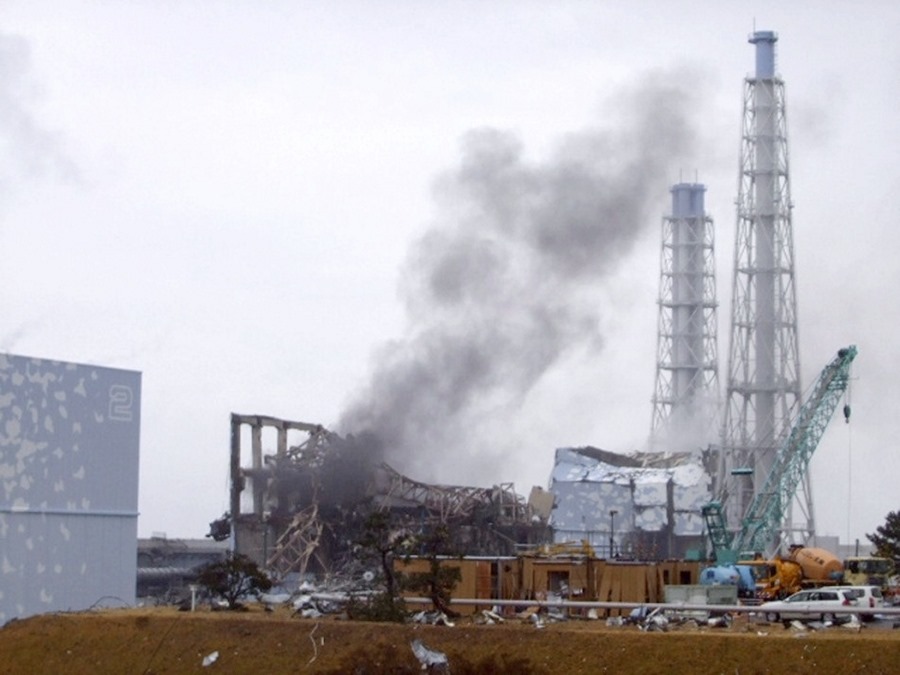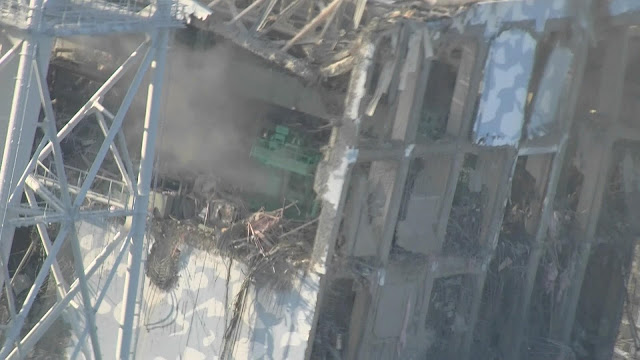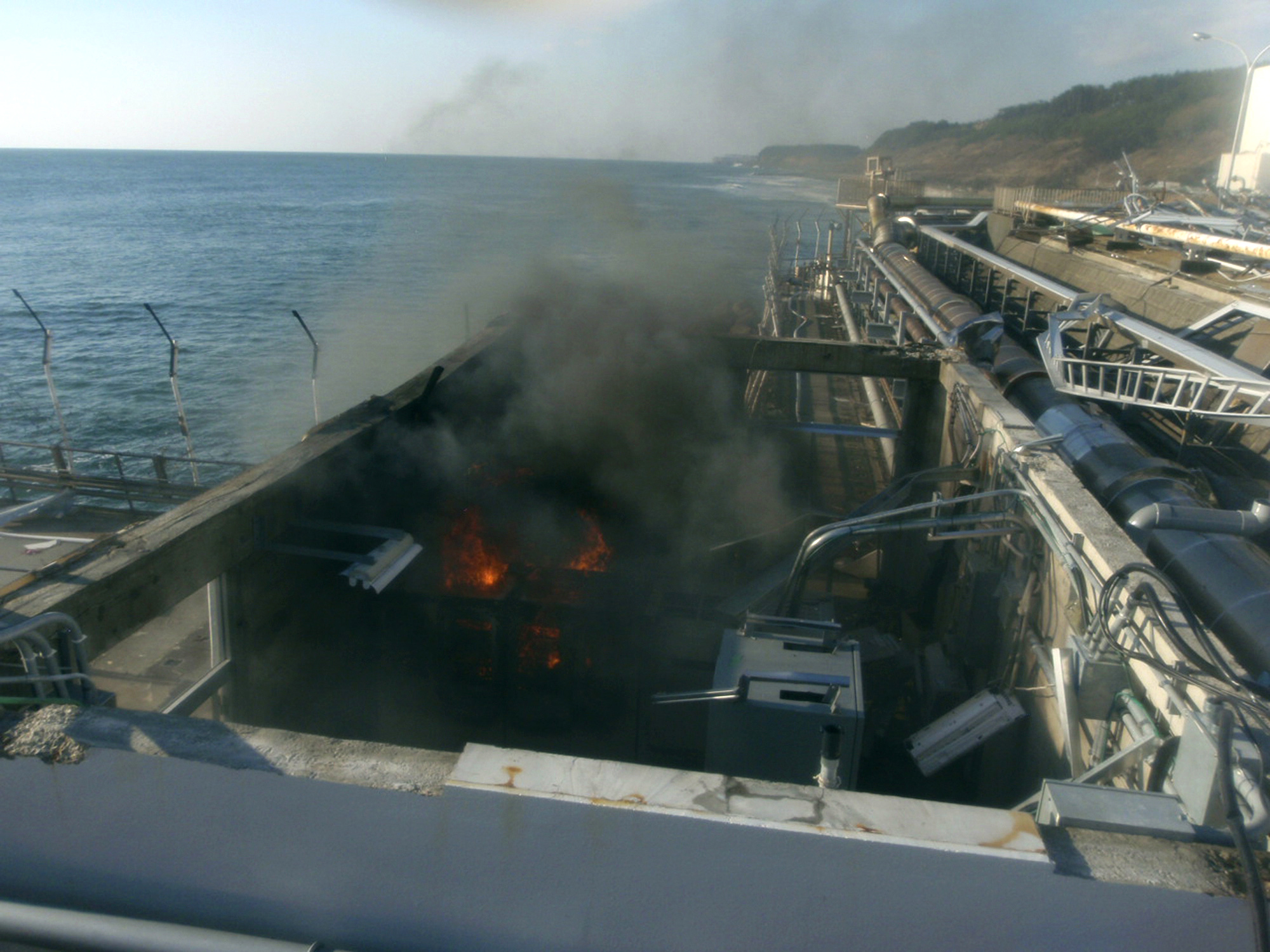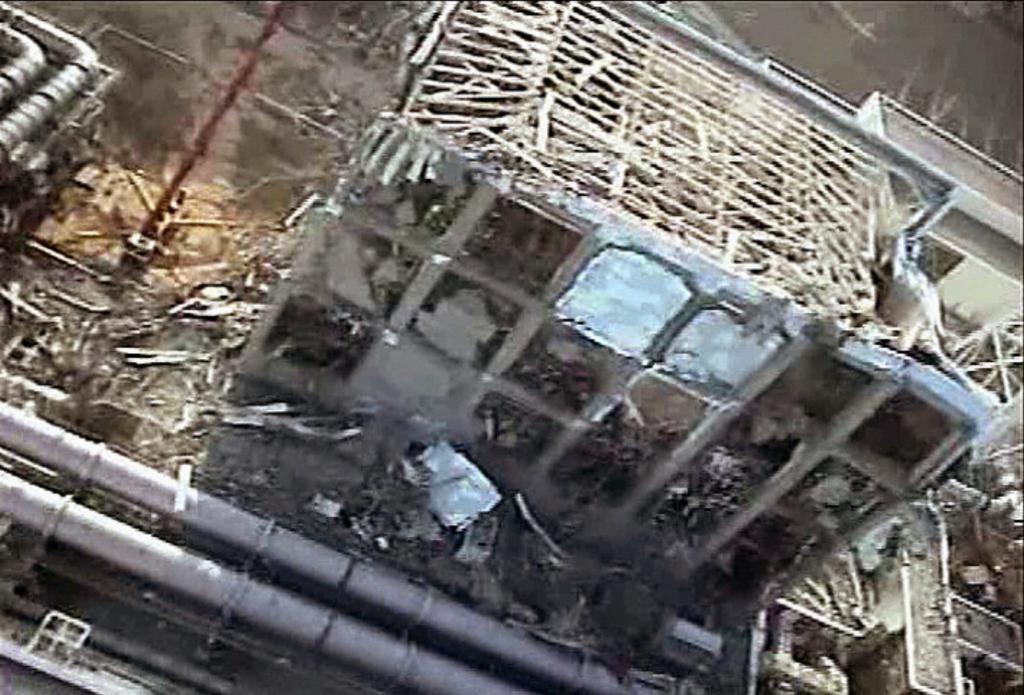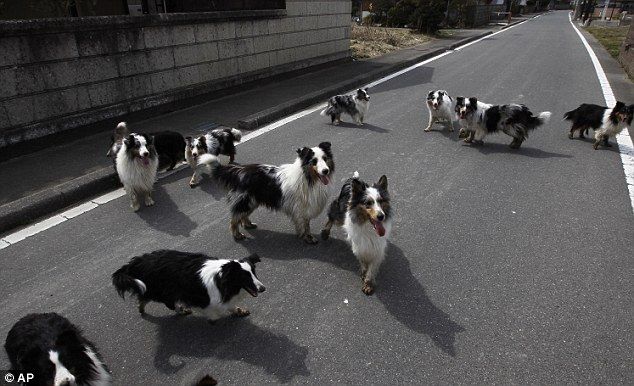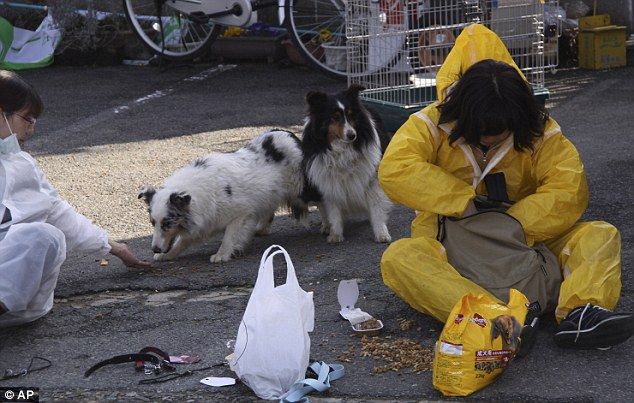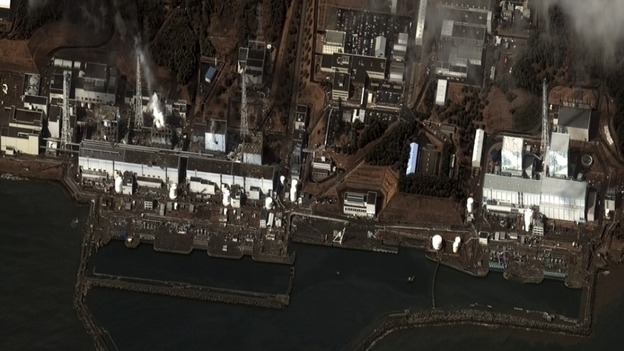|
|
|
|
April 11 to April 18
of the quake hit Fukushima Dai-ichi Nuclear Power Station Inages Credit - Kyodo |
|
|
April 11, 2011 A geotechnical expert has determined that the March 11th earthquake
caused liquefaction in at least 4,200 hectares of land along Tokyo Bay. Professor Susumu Yasuda of Tokyo Denki University conducted a survey on the extent of liquefaction in areas around the bay. Tokyo lies at a distance of about 370 kilometers from the quake's epicenter. He says the liquefaction was concentrated in land that was reclaimed relatively recently, or after 1966. Liquefaction severely damaged residential areas built on reclaimed land in Urayasu and Narashino cities in Chiba Prefecture. Work to restore sewage systems is progressing quickly, but little has
been done to prevent liquefaction itself.
Fukushima Dai-ichi Reactor No. 4 - March 16, 2011
April 12, 2011 Japan to raise Fukushima crisis level to worst The Japanese government's nuclear safety agency has decided to raise the crisis level of the Fukushima Daiichi power plant accident from 5 to 7, the worst on the international scale. The Nuclear and Industrial Safety Agency made the decision on Monday. It says the damaged facilities have been releasing a massive amount of radioactive substances, which are posing a threat to human health and the environment over a wide area. The agency used the International Nuclear and Radiological Event Scale, or INES, to gauge the level. The scale was designed by an international group of experts to indicate the significance of nuclear events with ratings of 0 to 7. On March 18th, one week after the massive quake, the agency declared the Fukushima trouble a level 5 incident, the same as the accident at Three Mile Island in the United States in 1979. Level 7 has formerly only been applied to the Chernobyl accident in the former Soviet Union in 1986 when hundreds of thousands of terabecquerels of radioactive iodine-131 were released into the air. One terabecquerel is one trillion becquerels. The agency believes the cumulative amount from the Fukushima plant is less than that from Chernobyl. Officials from the agency and the Nuclear Safety Commission will hold a news conference on Tuesday morning to explain the change of evaluation. |
|
|
April 12, 2011
TOKYO, April 12, Kyodo A fire broke out at the crisis-hit Fukushima nuclear plant in northeastern Japan Tuesday morning, but was soon extinguished, the plant operator said. Tokyo Electric Power Co. said the fire occurred at the sampling building near a water outlet at the Fukushima Daiichi nuclear power plant's No.4 reactor and was spotted by a worker. There was no change in the levels of radiation around the reactor, the utility known as TEPCO added. The nuclear plant was crippled after a mega quake and tsunami hit northeastern Japan on March 11. April 12, 2011 TOKYO, April 12, Kyodo |
|
Fukushima Dai-ichi Reactor No. 4 - April 10, 2011
Nuclear accident level raised to maximum Official now with more numbers to ponder... but they are still saying 1/10th of Chernobyl... Just who are they trying to con? Surely anyone with internet access can look up the numbers... I know right now NHK is still our best source but someone needs to walk into their office and slap these reporters upside the head: Japan's nuclear safety agency has raised the crisis level at the stricken Fukushima Daiichi nuclear power plant to 7, from the current 5. The agency told reporters on Tuesday that large volumes of radioactive substances that could affect human health and the environment are being released in a wide area. Level 7 is the highest rank on an international standard and equivalent to the severity recorded after the Chernobyl disaster in 1986. But the agency said the volume of radiation from Fukushima is one-tenth that at Chernobyl. The agency said its calculations show that 370-thousand terabecquerels of radioactive iodine 131 and cesium 137 have been released from the plant. The nuclear safety commission, in a joint press conference with the agency, put the estimated leak at 630-thousand terabecquerels of both substances. One terabecquerel is equivalent to one trillion becquerels. Both organizations say the leak constitutes a level-7 crisis. Senior agency official Hidehiko Nishiyama said 29 people died of acute radiation exposure at Chernobyl but there are no fatal radiation casualties at Fukushima. He added that at Chernobyl the nuclear reactor itself exploded in contrast to the Fukushima plant, which was damaged by hydrogen explosions. He said the reactors themselves retain their shape. Nishiyama also said the upgrade does not affect the existing evacuation plan, which was made on the basis of the same radiation evaluation. The agency is required to announce the severity of a crisis at a nuclear facility based on the international standard from zero up to 7 set by the International Nuclear Event Scale. |
|
|
April 12, 2011 TOKYO, April 12, Kyodo Minute amounts of radioactive strontium have been detected in soil and plants in Fukushima Prefecture beyond the 30-kilometer zone around the crippled Fukushima Daiichi Nuclear Power Station, the science ministry said Tuesday. It is the first time that radioactive strontium has been detected since the Fukushima plant began leaking radioactive substances after it was severely damaged by the March 11 earthquake and tsunami. There is no safety limit set by the government for exposure to strontium, but the amount found so far is extremely low and does not pose a threat to human health, the Education, Culture, Sports, Science and Technology said. Experts, however, expressed concern that the accumulation of strontium could have adverse health effects. When strontium enters the human body, it tends to accumulate in bones and is believed to cause bone cancer and leukemia. Samples of soil and plants were taken March 16 to 19 from a number of locations in Fukushima Prefecture. The government has designated the area within a 20-km radius of the plant as an evacuation zone, while people residing in areas in the 20- to 30-km ring have been asked to remain indoors. On Monday, the government expanded the evacuation zone to some municipalities beyond the 20-km radius where residents will evacuate in around a month. |
|
|
April 14, 2011
Alexander Kovalenko, who served as deputy director of the Chernobyl
Nuclear Power Plant and head of the department of information and international
relations of the government commission for the liquidation of the Chernobyl
Nuclear Plant disaster following the 1986 accident at the plant, said in
an interview with Interfax‘ Vyacheslav Terekhov what the large amounts
of radioactive waste located at the Fukushima-1 nuclear plant may mean
and whether the rumors that there could have been a secret military laboratory
in the station could be grounded. |
|
| April 14, 2011 Originally posted by makeitso Ibaraki Environmental Radiation Monitoring - Wind air dose rate Measurement Result Realtime Monitoring Ibaraki Prefecture Miyagi Prefecture Radiation Monitoring View real-time environmental radiation - Kawasaki District - Yokosuka District Live Stream Tweets - #Reactors Originally posted by imlite Groundwater radiation level at nuke plant rise: The concentration levels of radioactive iodine and cesium in groundwater
near the troubled Nos. 1 and 2 reactors at the Fukushima Daiichi nuclear
power plant have increased up to several dozen times in one week, suggesting
that toxic water has seeped from nearby reactor turbine buildings or elsewhere,
Tokyo Electric Power Co. said Thursday.
Kyodo news And the creation ratios for iodine and caesium in the reactor buildings sub-drains seem to show periodic criticality occuring in the reactors - probably in reactor 2. TEPCO Monitoring - [PDF] |
|
| April 14, 2011 Groundwater radiation level at nuke plant rises: TEPCO TOKYO, April 14, Kyodo
The concentration levels of radioactive iodine and cesium in groundwater near the troApril 15, 2011ubled Nos. 1 and 2 reactors at the Fukushima Daiichi nuclear power plant have increased up to several dozen times in one week, suggesting that toxic water has seeped from nearby reactor turbine buildings or elsewhere, Tokyo Electric Power Co. said Thursday. The announcement came as the plant operator continued to grapple with pools of highly radioactive water found on the plant's premises, with the level of polluted water filling an underground trench edging up again after the company finished pumping out around 660 tons of water. According to the latest findings, a groundwater sample taken April 6 near the No. 1 reactor turbine building showed radioactive iodine-131 of 72 becquerels per cubic meter, with the concentration level growing to 400 becquerels as of Wednesday. The concentration level of cesium-134 increased from 1.4 becquerels to 53 becquerels. The government's nuclear regulatory agency said it had ordered the utility firm known as TEPCO to enhance monitoring of groundwater inside the plant, which is located on the Pacific coast. A total of around 60,000 tons of contaminated water is believed to be flooding the basements of the Nos. 1 to 3 reactor turbine buildings as well as trenches connected to them, and the water is hampering work to restore the cooling functions of the reactors lost since the March 11 earthquake and ensuing tsunami. The pools of contaminated water are believed to be a side effect of TEPCO's emergency efforts to continue injecting water into the reactors and their spent nuclear fuel pools from outside to cool them down. TEPCO pumped out around 660 tons of highly radioactive water Tuesday and Wednesday from one of the trenches to a ''condenser'' inside the nearby No. 2 reactor turbine building, where during normal operation steam from the reactor is converted into water. But the Nuclear and Industrial Safety Agency said the water level in the vertical part of the trench as of 11 a.m. Thursday had increased by about 4.5 centimeters from the level observed at 6 p.m. Wednesday. The level of the water is now only 1.5 centimeters lower than shortly before the water-transfer mission started at 7:35 p.m. Tuesday. Hidehiko Nishiyama, the agency's spokesman, told a press conference Thursday morning that the rise in the water level is likely linked to the continued injection of water into the No. 2 reactor core, which is necessary to prevent the nuclear fuel inside from overheating. ''As there is believed to be around 20,000 tons of water (in the No. 2 reactor turbine building and the trench connected to it), we're feeling the difficulty of lowering the level of the water in a stable manner,'' he said. TEPCO is preparing to transfer more of the highly radioactive water into a facility for nuclear waste disposal at the plant, which can accommodate 30,000 tons of liquid. Work is under way to ensure that the facility will be able to contain highly radioactive water safely without fear of the stored liquid leaking outside, but Nishiyama told the press conference that he was not sure when it would end. The water in and around the No. 2 reactor turbine building is believed to contain higher concentrations of radioactive substances than other contaminated water found at the site, and is believed to originate from the No. 2 reactor's core, where fuel rods have partially melted. The agency decided to remove water from the trench first as it feared that the water inside the trench would overflow and leak into the Pacific Ocean. TEPCO also started looking into how to check the quake resistance of already heavily damaged reactor buildings at the site in line with an order issued Wednesday by the nuclear regulatory agency, in light of a series of strong aftershocks of the March 11 quake. The agency has told the utility to immediately examine the buildings and consider reinforcement work if they are judged as not sufficiently quakeproof. TEPCO, however, has said that it cannot ''immediately conduct an investigation'' unless it confirms the safety of areas where checks will be conducted. To enhance preparation for tsunami waves triggered by aftershocks and other emergency situations, emergency diesel power generators and vehicle-mounted power sources are to be placed on higher ground, while backup units for water injection at the troubled Nos. 1 to 3 reactors are expected to be installed, according to the nuclear agency. Meanwhile, concern grew over the state of the No. 3 reactor at one point, as the agency said in the afternoon that the temperature of part of its reactor pressure vessel was found to be rising suddenly. But TEPCO officials said the data were likely due to a glitch in a measuring instrument, because other temperature data related to the vessel has not shown a similar rise. Kyodo News |
|
| April 14, 2011 Originally posted by predator0187 :( Watched a program on this last night. They said people were told they would only be gone a few days so many left their pets at their homes. Now as it is not recommended to go back many pets are starving to death. There have been a few brave people that are going back and helping the animals out. They need to be cared about as well. Pred... Dog-lovers brave Fukushima nuclear danger zone to save abandoned
pets
Rescuers have been risking their lives in the nuclear swamp around tsunami-hit Japan's stricken power plant - to save abandoned dogs. Thousands of animals have starved to death or been abandoned by their owners after the earthquake and tsunami shattered Japan on March 11. A 20km exclusion zone was put in place around the damaged Fukushima nuclear power plant as deadly radiation spilled into the atmosphere.
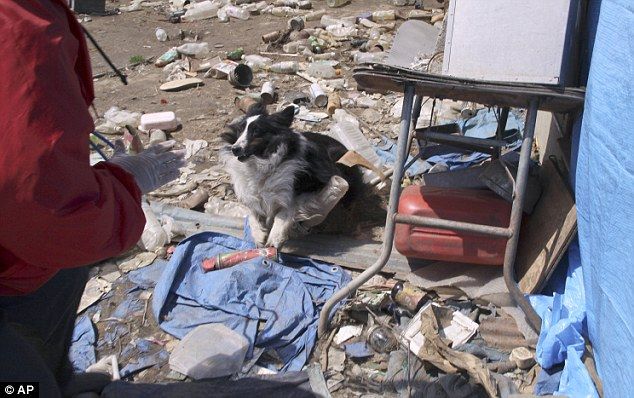
|
|
|
April 14, 2011 TOKYO, April 14, Kyodo The U.S. Department of Energy is shipping five large stainless steel tanks for storing water contaminated with radioactive materials and a tractor trailer with a shielded tank to the crippled Fukushima Daiichi nuclear power plant as part of its assistance, the U.S. Embassy in Tokyo said Thursday. The stainless steel tanks are expected to be used to store contaminated water from the basements of the Nos. 1 to 3 reactor turbine buildings and connecting trenches, while the tractor trailer equipped with the shielded tank will allow for contaminated water characterization. The pools of highly radioactive water are the major obstacles to work to restore the reactors' cooling functions lost after the March 11 earthquake and tsunami. Details regarding the size of the tanks and expected arrival date were
not immediately known. |
|
| April 14, 2011 Originally posted by Destinyone R4 is front and foremost in the news again... Thursday, April 14, 2011
Radiation surges above 4's fuel pool By KANAKO TAKAHARA STAFF WRITER Radiation has risen to high levels above the spent-fuel pool at reactor No. 4 and its temperature is rising, the nuclear safety agency said Wednesday, indicating the fuel rods have been further damaged and are emitting radioactive substances. The radiation level 6 meters above the spent-fuel storage pool at the crippled Fukushima No. 1 nuclear plant was measured at 84 millisieverts per hour Tuesday. Normally, it's 0.1 microsievert. [The temperature of the pool was 90 degrees, compared with 84 before it caught fire on March 15 in a suspected hydrogen explosion, the agency said. "It's quite an amount," figured Hidehiko Nishiyama, a spokesman for the Nuclear and Industrial Safety Agency. Tokyo Electric Power Co. was unsure whether the surge in radiation was being caused by the spent fuel rods or radioactive material leaking from the reactor's pressure vessel. "The temperature was rising and we don't know the water level of the pool, so we thought it would be safer to pour water," said NISA's Nishiyama said. Tepco said it is planning to move the spent fuel rods out of the storage pools at reactors 1 through 4 so they can be moved to a safer location, although details on when and how haven't been decided yet. Some of the options Tepco is considering include pulling the rods out with a crane or building a special structure nearby to pull them out. But these tasks will be tough because the site is so radioactive and cluttered with debris from last month's hydrogen explosions. Meanwhile, the water level of radiation-contaminated water in the tunnel-like trench at Unit 2 dropped by 4.3 cm Wednesday morning after Tepco started pumping lethally radioactive water from its flooded turbine room into a nearby storage facility the day before. SOURCE Des
|
|
| April 14, 2011 Originally posted byAnmarie96 TEPCO UPDATE Press Release (Apr 14,2011)
On April 12th 2011, in order to examine the condition of the spent fuel pool of Unit 4 of Fukushima Daiichi Nuclear Power Station, we collected 200ml of the water in the pool with the concrete pumping vehicle. On April 13th 2011, we conducted a nuclide analysis of radioactive materials with the water and as a result have detected some radioactive materials as shown in the exhibit. We are planning to evaluate the result in further detail.
The
Exhibit - [PDF] |
|
| April 14, 2011 Core Shroud Replacement Work Experience:World's First Replacement of Core Shroud 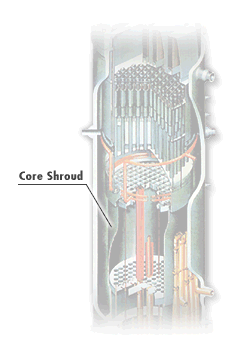  The
world's first shroud replacement project for a Boiling Water Reactor
(BWR) has been completed at Fukushima Daiichi Nuclear Power Station
Unit No.3 (1F-3), owned and operated by Tokyo Electric Power Company
(TEPCO). Toshiba was recognized for developing the technology that made this
achievement possible by being chosen as the main contractor for this
challenging project. ~ SOURCE
|
|
| April 16, 2011 Accumulated radiation tops 17,000 microsieverts in Fukushima's Namie TOKYO, April 16, Kyodo The accumulated radiation level in Namie, 30 kilometers from the crippled Fukushima Daiichi nuclear power plant, in the three weeks through Friday stood at 17,010 microsieverts, according to a tally released by the science ministry Saturday. The accumulated levels during the period starting March 23 stood at 9,850 microsieverts in Iitate and 495 microsieverts in Minamisoma, both near the plant, it said. The readings compare with the level of 1,000 microsieverts that ordinary people in Japan can expect to be exposed to over one year. The amount of radioactive cesium stood between 12.7 and 71.0 becquerels per liter of surface seawater near the plant on Monday and Wednesday and 10.1 becquerels at deeper levels on Monday, the Ministry of Education, Culture, Sports, Science and Technology said. |
|
| April 17, 2011 Smoke rises from control panel at TEPCO nuclear plant in Niigata NIIGATA, Japan, April 17, Kyodo Smoke rose briefly from a control panel at a nuclear power plant in Niigata Prefecture on the Sea of Japan coast Saturday, the operator Tokyo Electric Power Co. said. No one was injured in the 7:45 p.m. incident that occurred during the checking of water purification equipment at the Kashiwazaki-Kariwa nuclear complex, the company said, adding it has yet to determine the cause. The utility is currently battling to bring the Fukushima Daiichi nuclear power plant under control. Smoke rises from Japan nuclear plant
Sat Apr 16, 2011 4:59PM Japan's Tokyo Electric Power Co. (TEPCO) says smoke has risen from the
Kashiwazaki-Kariwa nuclear plant in the coastal Niigata Prefecture.
TEPCO reported on Saturday that smoke rose briefly from a control panel at the Kashiwazaki-Kariwa nuclear power plant during the checking of water purification equipment. It added that the cause of the incident was not clear, but no one was injured. TEPCO is the operator of Japan's Fukushima power plant which was damaged when a massive earthquake and tsunami hit the country's northeastern coasts on March 11. Last week Japan's Nuclear and Industrial Safety Agency raised the severity level of the situation at Fukushima from 5 to 7 -- the worst on an international scale. According to the agency, the amount of radiation emissions at the Fukushima plant was equivalent to 10 percent of that in the Chernobyl accident. Severity level of 7 had only been applied to the 1986 Chernobyl accident in Ukraine. An explosion and ensuing fire in Chernobyl nuclear power plant resulted in a severe release of radioactivity into the environment, claiming the lives of at least 4,000 people. |
|
|
April 17, 2011 TOKYO, April 17, Kyodo The U.S. government has told Japan that it can use a U.S. unmanned cargo transport helicopter to set up cranes to remove spent fuel rods from storage pools at the crippled Fukushima nuclear power plant, Japanese and U.S. sources close to the matter said Saturday. The K-MAX helicopter, developed jointly by Lockheed Martin Corp. and KAMAN Aerospace Group of the United States, is being considered to set up the huge cranes. The proposal has been communicated to the unified command headquarters set up by the Japanese government and Tokyo Electric Power Co. to deal with the nuclear crisis. Japan has not yet made a formal response to the proposal. Since the ground positioning system-equipped chopper can be operated remotely, it would enable emergency workers to implement restoration work even in areas contaminated by high levels of radiation, they said. TEPCO has been cooling down the spent fuel storage pools on the fifth floor of the reactor buildings by pumping water using a truck-mounted concrete pump. Spent nuclear fuel is usually transported away from nuclear plants inside steel casks after being cooled in storage pools for a few years. Since the original fuel transportation equipment at the Fukushima plant's reactor buildings was damaged by hydrogen explosions following the March 11 quake and tsunami, TEPCO is considering employing a huge crane to lift casks into the storage pools so that spent fuel rods can be placed in them. The United States has proposed transporting partially assembled cranes to the plant using the unmanned helicopter. It has also proposed starting full-fledged installation of the cranes after radiation levels fall. The proposal was originally conveyed by Adm. Robert Willard, commander of the U.S. Pacific Command, at a meeting in late March with his Japanese counterpart Self-Defense Forces Chief of Staff Ryoichi Oriki, the sources said. The U.S. side is ready to transport the unmanned helicopter by plane from the United States to the Matsushima base of the Air Self-Defense Force in Higashimatsushima, Miyagi Prefecture, they said. The K-MAX helicopters belong to the U.S. Marine Corps. The remote-controlled choppers were introduced by the U.S. military after a number of manned helicopters were shot down by insurgents in Afghanistan. The improved version of the K-MAX can lift around 1.4 tons. Kyodo News |
|
| April 17, 2011 TEPCO ignored tsunami warnings for years The Yomiuri Shimbun This is the sixth and final installment in a series focusing on delays in implementing emergency steps by the government and Tokyo Electric Power Co. to deal with the unprecedented nuclear crisis at the Fukushima No. 1 nuclear power plant. About 30 minutes after the March 11 earthquake hit, an employee of a Tokyo Electric Power Co. subcontractor working in a building near one of the Fukushima No. 1 nuclear power plant's reactors heard an ominous roar. The worker was hearing the giant tsunami that was about to swamp the nuclear plant--an unstoppable wall of water that would easily breach the plant's breakwater and proceed to wash away the pumps that supplied water to cool the nuclear reactors. Safe on higher ground, another worker turned to look at the ocean and noticed a huge bowllike object floating out at sea. It was the fuel tank for the emergency diesel generators, he realized. The Fukushima plant survived the enormous shaking caused by the magnitude-9.0 temblor because of earthquake safety measures put in place long before. Against the tsunami, however, the nuclear power station was almost defenseless. Most of the power plant sits on ground about 10 meters above sea level. But most of the 13 emergency generators were in the basements of reactor buildings close to the ocean, with only three aboveground. The only generator that survived the tsunami--which are believed to have reached heights of 14 meters or 15 meters--was the one for the No. 6 reactor, which was about 3 meters aboveground. TEPCO had said in the past that a situation where all the nuclear reactors lost all their power sources would be "unthinkable," no matter how bad the disaster. On March 11, the unthinkable became reality. On March 18, TEPCO President Masataka Shimizu issued a statement on the nuclear crisis: "The accident was caused by the violence of nature--a tsunami caused by an unprecedented earthquake--and it is regrettable the crisis has escalated to such an extreme state of affairs." The statement effectively shows that TEPCO sees the crisis as due entirely to the massive scale of the natural disaster. Warnings had been made Nuclear power specialists had also underestimated the threat posed by tsunami. In February 2007, Haruki Madarame, now chairman of the government's Nuclear Safety Commission, testified at a lawsuit trying to shut down Chubu Electric Power Co.'s Hamaoka nuclear plant in Shizuoka Prefecture. Madarame, a University of Tokyo professor at the time, was a witness for the defense. Asked in court why the nuclear plant did not need to prepare for a situation in which all equipment had stopped operating, including emergency power sources, he said: "There needs to be a line drawn somewhere. It'd be impossible to design [a nuclear plant] if engineers had to consider every single possibility." However, different experts had warned TEPCO on several occasions about the possibility of a massive tsunami striking the Fukushima No. 1 plant. Yukinobu Okamura, director of the Active Fault and Earthquake Research Center, harshly criticized TEPCO's plan to revise its seismic-resistant designs at the Fukushima No. 1 plant at a meeting of an expert panel under the Economy, Trade and Industry Ministry in June 2009. "This plan doesn't even mention the major tsunami that have happened in the past. I'm not convinced at all," he said. About 1,100 years ago, a gigantic earthquake caused tsunami that hit a wide swath of the coast of what is now Miyagi and Fukushima prefectures, according to the National Institute of Advanced Industrial Science and Technology, which oversees the Active Fault and Earthquake Research Center. Called the Jogan Tsunami, the waves reached about three kilometers or four kilometers inland in the Sendai Plain and other areas, according to the institute, but TEPCO's new plan made no mention of this historic natural disaster. The expert panel compiled a report the next month, but this also failed to refer to the Jogan Tsunami and concluded it was acceptable to put off making nuclear plants more able to withstand tsunami. The Diet had also been made aware of the threat. Five years ago, House of Representatives member Hidekatsu Yoshii submitted a written question to the lower house asking whether the government fully grasped the possibility that the nation's nuclear power plants could lose all power due to an earthquake or tsunami. Yoshii belongs to the Japanese Communist Party. The response from the government was bureaucratic: "The Economy, Trade and Industry Ministry has inspected the safety of nuclear reactors, and the adequacy of its judgment has been confirmed by the Nuclear Safety Commission." Tokai No. 2 fared better Japan Atomic Power Co.'s Tokai No. 2 plant in Tokaimura, Ibaraki Prefecture, was hit by a 5-meter tsunami on March 11 but the plant's cooling systems kept functioning. Learning from the Kashiwazaki-Kariwa nuclear power plant, which was damaged by the 2007 Niigata Prefecture Chuetsu Offshore Earthquake, the firm increased the height of the tsunami the Tokai plant should be prepared for and built a protective wall. The safety measures proved their worth on March 11, protecting two of the plant's three emergency power sources. After the March 11 disaster, the government's Nuclear and Industrial Safety Agency waited about a month before taking any action regarding tsunami. Only on April 9, two days after a magnitude-7.1 aftershock hit the Tohoku region, did the agency instruct power companies to ensure each nuclear plant have at least two emergency generators that would remain functional after a natural disaster. TEPCO and the government clearly underestimated the warnings that were being sounded over the Fukushima plant's lack of tsunami-protective measures. As of Monday, the firm still had the following statement on its Web site: "We have confirmed the safety [of our nuclear plants] by assessing the impact of a tsunami stronger than the largest ever reported using a numerical simulation." The Yomiuri Shimbun |
|
|
April 17, 2011 A journalist worth following: Many members on ATS have learned to cry wolf when we see the teeth come out. TEPCO is showing its teeth. TEPCO is using it's teeth, not to inform or save people, but to bite back and control the media, suppress information, and buy their way to the news headlines they want run. No. I don't trust them. Neither does this journalist and for people like him, many of us are thankful. Yes, he is taking the hits and losing jobs on controlled media. Just yesterday there were calls to remove a member of the Japanese government who dared say it could be years before people could return to their homes near the plant. Tell the truth and you will be bitten. Fortunately the internet now allows people across the world to talk to one another and share information. In a nuclear disaster: a company with a vested interested in downplaying the crisis should never be allowed to control the dispersal of information. What we can't see can hurt us. Next time you see the words none detected - know that this also means they didn't test for a radioactive substance at all. Takashi Uesugi: The Interview
One of the most influential members of this group of dissenters is Takashi Uesugi, a former New York Times journalist and, in an earlier incarnation, aide to Liberal Democratic Party bigwig Kunio Hatoyama. The author of books including The Collapse of Journalism, Uesugi is a vociferous critic of Japan's 'Kisha Club' system – a network of exclusive press clubs that, he says, nurtures excessively close relationships between reporters and the organisations they are supposed to cover. Obviously a lot has happened over the past couple of weeks, but what are the main things you've learned? Basically, something that I knew from the beginning, but has become more blatant yesterday and today [March 27-28], is this terrible situation where the government and TEPCO are suppressing information. To be more specific, I thought it was strange that there was nothing written about plutonium when the data about reactor 3 was given out at the TEPCO press conference on the 27th, so I asked them if it was true that no plutonium had been detected in reactor 3, and for how long it had not been detected. TEPCO answered: 'Plutonium hasn’t been detected.' To confirm what they were saying I asked if perhaps it wasn't that none had been detected, but that they hadn't actually taken any measurements. They were alarmed, and it turned out that it wasn't even that they hadn't taken any measurements, but that they didn't have the instruments to do so in the first place. That's one example. TEPCO are such an important advertiser that the television and newspapers are completely silent. Even now, they're running TEPCO commercials on the television, aren’t they? This week, there are also full-page advertisements in the newspaper. Despite the fact that they've caused such a scandal, TEPCO are still putting ads in the newspaper. If they have such enormous sums of money, they should send it to the areas hit by the disaster. We on ATS, will also continue to call it like we see it. TEPCO is suppressing information and lying. From his website: Freelance, online reporting discouraged on nuclear threat The Japanese government upped the danger rating for the disaster at the Fukushima Daiichi Nuclear Power Station to its highest level, 7, on Tuesday, a month after an earthquake and tsunami devastated the country. It was not yet clear whether the administration or the Tokyo Electric Power Company, which runs the plant, withheld the extent of the risk. But the local media’s habitual allegiance to officials who arrange press conferences and companies that buy advertising makes it hard to tell, and freelancers who are eager to probe deeper say their questions have been suppressed. Takashi Uesugi, an author and freelancer with an active website and Twitter page, has been asking just that. He told The New Yorker and Time Out Tokyo that the government excluded Internet and foreign media from official press conferences after March 11, effectively avoiding tough questions. His complaint has not been well received in Japan. “I have been frustrating TEPCO, government and all the Kisha Club media,” Uesugi told CPJ by email. Appearing in his weekly guest slot on the local TBS radio station on March 15, he launched into a strong criticism of the power company. The station asked him not to come back. “I was removed from my slot on the TBS program permanently,” Uesugi wrote. Why the caution? Japanese journalist Makiko Segawa writes that journalists are hoping to preserve their portion of the $120 million TEPCO lays out annually in media advertisements. On April 6, she told CPJ by email, the Ministry of General Affairs announced a task force to enforce guidelines for Internet sites deemed to be spreading false rumors. Gossip about the risk increased as public trust in official sources of information declined, international news reports say. The Telecom Services Association, one of the Japan’s leading internet providers, revealed April 8 that they had complied with some of the task force’s requests, resulting in the removal of prohibited information, such as images of corpses, from the Internet, Segawa wrote. “The media has not covered this story,” she told CPJ. The people on the ground are the ones the government should be working to protect–not TEPCO’s interests, or its own grip on information. |
|
|
April 17, 2011 Desperate times call for desperate measures? 13th April - Tepco Wants to Hasten Restart of Kashiwazaki Kariwa Reactor 14th April (Bloomberg) -- Tokyo Electric Power Co. wants the government to hasten approvals for the restart of a reactor shut by an earthquake in 2007 as Japan grapples with power shortages after last month’s disaster. Kashiwazaki Kariwa, the world’s biggest power plant, was shut in July 2007 after a quake bigger than anticipated in its design struck Niigata, northwest of Tokyo, triggering a fire and radiation leaks. - Source Hasten approvals? I hope that doesn't including cutting corners and ignoring safety protocol Tepco. 16th April - Smoke at another Japan nuclear plant TOKYO — Smoke briefly rose Saturday from a control panel at a Japanese nuclear power plant operated by the same company battling to stop radiation seeping from a quake-stricken facility, a report said. There were no injuries but the cause of the smoke at the plant in coastal Niigata prefecture was not clear, Kyodo news said, citing Tokyo Electric Power Co. (TEPCO). - Source A little more on the Kashiwazaki-Kariwa plant here:
In an
effort to pacify its critics, TEPCO held a simulated earthquake
drill in January at Kashiwazaki-Kariwa, the first time it had done so
at
any of its plants. But while TEPCO said the plant passed the test,
which
was based on a 7.0 tremor, it did little to mollify local residents.
“The information comes only from TEPCO. They never allowed a third
party to conduct any tests, so we don’t know what to believe… We
feel that the reason they didn’t test for a 7.5 or 8.0 magnitude quake
is because the plant couldn’t stand it,” said Chie Takakiwo, a
65-year-old
retired high-school teacher. ” - Source
Considering Japans geology, was it wise to build nuclear plants that could not withstand +7 mag earthquakes? Japanese put their faith in a system that has consistently failed to predict the risk of major earthquakes, says scientist. - Source I would say that the Japanese used lies and propaganda to further a business plan. I don't believe for a minute that they failed to notice the records of these recent quakes: 1.16.1995 City: Kobe Deaths: 5,502 Mag: 6.9 Tsunami/Fires: Yes 6.28.1948 City: Fukui Deaths: 3,769 Mag: 7.3 Tsunami/Fires: Yes 12.20.1946 City: Nankaido Deaths: 1,362 Mag: 8.1 Tsunami/Fires: Yes 1.12.1945 City: Mikawa Deaths: 1,961 Mag: 7.1 Tsunami/Fires: No 12.7.1944 City: Tonankai Deaths: 998 Mag: 8.1 Tsunami/Fires: Yes 9.10.1943 City: Tottori Deaths: 1,190 Mag: 7.4 Tsunami/Fires: No 3.2.1933 City: Sanriku Deaths: 3,000 Mag: 8.4 Tsunami/Fires: Yes 3.7.1927 City: Tango Deaths: 3,020 Mag: 7.6 Tsunami/Fires: Yes 9.1.1923 City: Kanto Deaths: 142,800 Mag: 7.9 Tsunami/Fires: Yes Source Earthquake Map Wikipedia's List of Japanese Quakes |
|
|
April 17, 2011 I have found a nice source of information. Credit goes to this website: Daily Kos Here are a few links: TEPCO
Roadmap Towards Restoration - [PDF][Archived] Plus lots more. I thought I would add this blog for those of you that like the more technical analysis's of the situation : Atomic Power ReviewOriginally posted by Maluhia I found this blog/diary written by Dr. Genn Saji, who was once Secretariat
of Japan's Nuclear Safety Commission. It contains daily entries back
to the beginning of the crisis. The fact that the blog is so "on
the down low" made me suspicious, but he was the Secretariat and he does
have inside knowledge regarding the plant.
If its already been posted - apologies. Although not shown at all in the PSAR, the sub-drain pits collect
underground water springing out from the land to the buildings when the
ground water level is higher than the lowest floor level of the buildings.
In the ordinary situation, the underground water is collected to the sub-drain
pit and then pumped out to the sea by the sub-drain pumps. It seems to
be an practice to construct four sub-drain pits at the corner of the buildings.
In the newer plants, the sub-drain pits are made to allow access from inside
of the buildings. With extended loss of the electric power, it appears
that the sub-drain pumps are not working to pump the sub-drain water out
to the sea. Once the contamination level reached to this level, the sub-drain
pit water should be treated as a low level active waste, being 3 orders
of magnitude higher than the drinking water criteria.
(1) Pit water situation Even after transferring 660 tons of the highly contaminated water from 1F2 pit, the water level has now increased to 88.5 cm from the previous 91 cm. The water level is increasing by 2-3 cm a day. TEPCO is struggling to prepare Centralized Waste Processing Facility, by checking cracks in concrete, applying water leak stopping chemicals (water-glass) into the nearby soil. Their projection is that the facility should be available by Monday, next week. The ground water seepage problem is going to become more difficult when this part of the country goes into a rainy season, an average arrival time in this district is June 10 to July 23, although it may either advance or delay several days easily. It is very prudent to transfer all of the highly contaminated water before arrival of the rainy season to reduce radiation risks as low as reasonably achievable. In the future, a total radiation risk consideration may become necessary, in case of unavoidable situations. (2) The underground water level should be kept below the lowest
floor level of the plant, below OP-2.06 (more preferably OP-3.36 which
corresponds to the lowest level of the suppression pool room) which corresponds
to the lowest level (except for the suppression pool room) of the reactor
building. This level correspond to GL-12.06m. It appears that the current
level of the underground water has already exceeded this level.
(3) The nitrogen gas charging to the 1F1 containment vessel continues, so far charged 5,200 m3, approaching close to their planning of 6,000 m3. Since the containment pressure is unchanged, it is likely there exists some leak in the containment vessel. ~ SOURCE |
|
|
April 18, 2011 Originally posted by DancedWithWolves The Japan Nuclear Safety Commission has now proven itself to be a useless entity and is as guilty as TEPCO. This lack of response is disgusting and further evidence that the nuclear industry has no, nada, oversight. Trust is forever gone. Japan Nuclear Safety Commission members arrive in Fukushima 37 days after quake Members of the Japan Nuclear Safety Commission were dispatched to Fukushima Prefecture on April 17, more than a month after a massive quake and tsunami crippled a nuclear power plant in the prefecture. Under the government's disaster prevention plans, members are supposed to go "immediately" in the event of a nuclear power plant accident. Commenting on the reason for their delayed arrival, a representative of the commission's secretariat explained that the commission had been busy following up inquiries from the government's disaster countermeasures headquarters and related government agencies. Deputy Fukushima Gov. Masao Uchibori reported the members' arrival at a meeting of the prefecture's main office for disaster countermeasures on the evening of April 17. "I talked with members for the first time on the 38th day from the day of the earthquake disaster. I told them to go to local areas, listen to victims and respond appropriately," he said. Commission members, who were dispatched as specialists providing emergency
technological advice to the government's local headquarters for nuclear
disaster countermeasures, did not attend the meeting of the prefecture's
main office for disaster countermeasures or meet with Fukushima Gov. Yuhei
Sato -- a move that incurred his criticism. ~ Source
They only showed up on the scene after an article yesterday called them out for not responding immediately as they are required to do in an accident. Thirty-eight days later, they show up and do nothing. Criminal. Originally posted by Finalized Japan will restrict senior industry regulators from taking jobs at power companies, in response to criticism that the practice compromised safety and contributed to the country’s worst ever nuclear accident. Yukio Edano, chief cabinet secretary, said the government would ask senior bureaucrats at the ministry of economy, trade and industry, which regulates the electricity sector, to temporarily refrain from taking posts at power companies “in order not to raise the public’s suspicions”. However, it's only a "request" Although it is only a request, the government expects the officials to avoid a practice that is known in other countries as the “revolving-door”, .... Just so they can save "face" during this disaster. The government said that once the situation at Fukushima Daiichi
was under control, it would launch a more exhaustive review of Japan’s
nuclear power industry and how it is monitored. But to restore public confidence,
Mr Edano said it was essential to immediately put a block on senior bureaucrats
from taking jobs at electric power companies. Read the whole article at: Originally posted by DancedWithWolves To bring about a cold shutdown within nine months, TEPCO's roadmap
presumes that the pressure vessels of the No. 1, 2 and 3 reactors are sound
and that the containment vessels other than that of the No. 2 reactor are
all free of damage.
"These presumptions are in themselves ridiculous as they haven't been confirmed as facts. The plan is nothing but pie in the sky," lambasted Keiji Kobayashi, former instructor at Kyoto University Research Reactor Institute. Furthermore, attempts to bring the crippled plant under control have been repeatedly suspended due to a spate of aftershocks affecting the region, prompting another expert to fear that a massive tsunami triggered by a possible ocean-trench earthquake could further delay restoration work. "The plant could be hit by a massive tsunami topping several meters in height. Restoration work needs to proceed while taking heed of preventing a secondary disaster from happening," said Takashi Furumura, professor of seismology at the University of Tokyo's Earthquake Research Institute. As has been discovered and discussed in this thread (good job all), their timeline assumes the radiation levels are reduced before work can truly begin. I sincerely hope TEPCO and the government start sharing details about these plant's inner workings and possibly previously known and unreported problems so a better upfront plan can be developed (if it's even possible) to bring these radiation levels down and bring some hope to the situation. Based on what I have read, cracks in the shroud of all these units was a common and on-going problem. TEPCO: Full and updated blueprints and true facts are needed by people around the world here and elsewhere trying to help you develop front-end plans. Your SHHTF. You need help. Open the gates (not the ones that were stuck open during the first day of the crisis.) Please. |
|
| April 18, 2011 Launched in 2001, Magna is based in the southern Israeli city of Dimona. The defense security company specializes in producing and installing stereoscopic sensory and thermal imaging cameras. Siboni said that his company's cameras were probably not damaged in the quake and tsunami as they were placed high up. Theoretically, Magna is able to gain remote access to the cameras at Fukushima. But because the Japanese government has not yet given them the right to do so, Magna has not yet seen the images being recorded there. Two of the people working to save the Fukushima nuclear plant were at Magna headquarters in Israel about three weeks ago for training. ~ Source Israeli firm which secured Japan nuclear plant says workers there 'putting their lives on the line'. Magna CEO says Japanese workers at nuclear plant 'projecting business as usual' but says it is 'unclear if they are healthy due to the high level of radiation at the reactor, which is life-threatening.' ~ Source Default Magna BSP wins €320m French radar contract. The company's product detected all intrusion attempts
in a series of trials, with no false alarms.
Magna BSP of Dimona, Israel has won a contract to
supply radar systems for the French military's perimeter defense plan.
Magna CEO Haim Siboni told "Globes" that following the win in the competition,
the company expects orders from the French military of up to €320 million
over five years.
The trials took place at a French military base
in Orleans in recent weeks under the supervision of the French
Department
of Defense and French consortium Thales, which is the French military's
chief contractor on its perimeter defense project. ~ Source |
|
| FAIR USE NOTICE: This page contains copyrighted material the use of which has not been specifically authorized by the copyright owner. Pegasus Research Consortium distributes this material without profit to those who have expressed a prior interest in receiving the included information for research and educational purposes. We believe this constitutes a fair use of any such copyrighted material as provided for in 17 U.S.C § 107. If you wish to use copyrighted material from this site for purposes of your own that go beyond fair use, you must obtain permission from the copyright owner. | |
|
|
